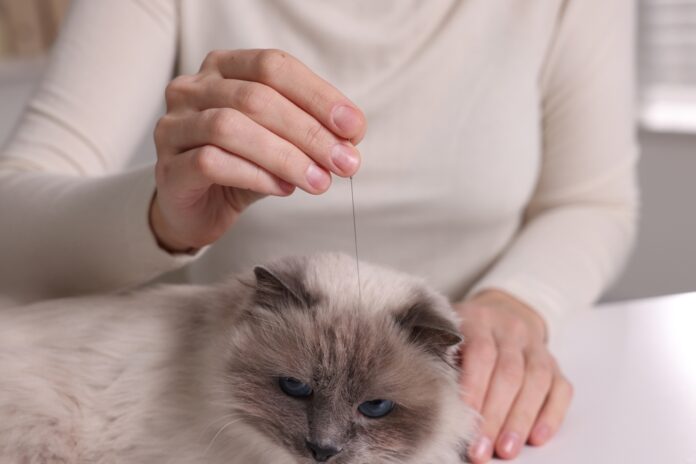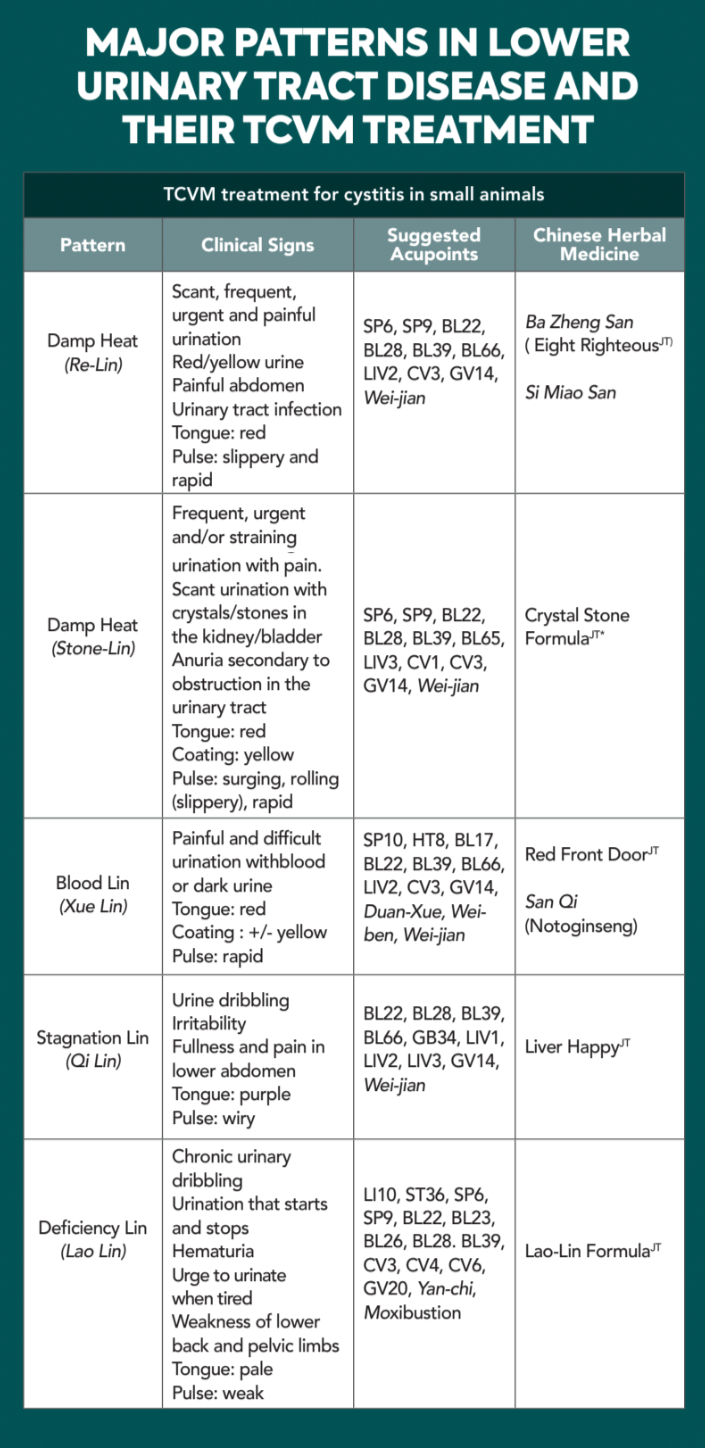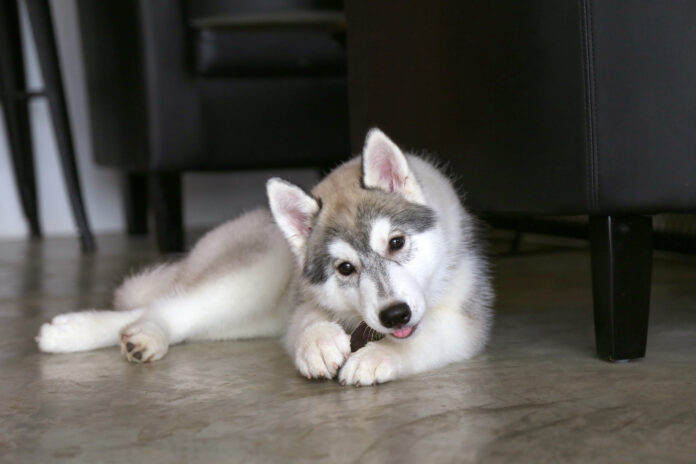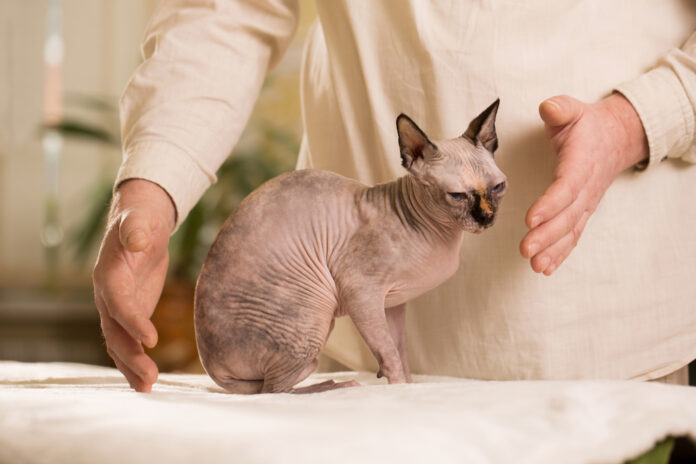TCVM for Chronic UTI in Dogs and Cats

Why Traditional Chinese Veterinary Medicine (TCVM) is more effective than conventional meds for dogs and cats with chronic UTI.
Chronic lower urinary tract inflammation (UTI) is one of the most challenging and frustrating conditions affecting our dogs and cats. In this article, we’ll look at how a Traditional Chinese Veterinary Medicine (TCVM) approach can be effective at treating this common problem.
DEFINING CHRONIC UTI
Chronic UTI is a recurrent or persistent bacterial infection of the bladder in the absence of neoplasia, stones, concurrent disease, and/or structural and functional abnormalities. The clinical signs include painful urination, the frequent and difficult passage of small amounts of urine, blood or crystals in the urine, dribbling, and a foul smell to the urine.
Tip: “Cystitis” describes bladder diseases that result in inflammation.
CHINESE MEDICINE LOOKS AT PATTERNS IN DISEASE
In Chinese Medicine, a disease is not traced back to a single cause, but rather to a combination of body signs and symptoms that are carefully analysed to determine a pattern. In fact, the ability to recognize patterns of illness is fundamental to Chinese Medicine. Two animals may have the same disease according to Western medicine, but the pattern of signs and symptoms can be different in each, and therefore require a different treatment strategy.
Tip: Chinese Medicine defines urinary tract infection as Lin Zheng
There are many patterns of Lin Zheng, but the form described here is commonly referred to as Urinary Bladder Damp Heat. The primary pathogenic factor seen in chronic UTI is Damp Heat, which can have multiple causes including inappropriate diet, obesity, and underlying Zang-Fu organ dysfunction that facilitates bacterial invasion of the bladder.
Multiple overlapping patterns are often responsible for the chronic nature of the disease, and these will vary depending on the individual. The most common pattern seen in longstanding bladder infections in dogs and cats is dual deficiency of the Kidney and Spleen. Chinese Medicine is often effective at treating and resolving chronic UTI because it can accurately identify the underlying patterns of disease responsible for its development and recurrence.
A Chinese medicine treatment plan may include the use of herbal medicine, acupuncture, food therapy, and conventional medications as needed. Antibiotics are energetically cold and bitter and effectively clear Heat.
Tip: Chronic use of antibiotics easily injures the Spleen, causes Liver Qi stagnation, and negatively impacts the normal bacterial flora of the gastrointestinal and urinary tracts.
Acute UTI often becomes chronic because residual Damp is not cleared and/or continues to be produced.
TCVM APPROACH TO CHRONIC UTI
Conventional Western medicine attributes acute and chronic UTI to an invasion of bacteria in the bladder. In acute uncomplicated UTI, a single course of antibiotics is usually sufficient to resolve the infection. However, conventional treatment is unable to recognize other contributing disease factors responsible for the development of chronic UTI. Low-dose chronic antibiotic therapy is often prescribed for the life of the animal, with increased potential for the development of antimicrobial resistance and superinfection over time.
In Chinese medicine, chronic UTI is considered multifactorial and develops from external and internal causes. The basic pathophysiology revolves around the presence of Damp Heat.
This can result from the invasion of Damp Heat pathogens (bacteria), or is generated internally from Zang-Fu organ dysfunction. Damp Heat obstructs the normal Qi activity of the bladder, resulting in pain, difficulty urinating, etc. Damp Heat can transform into Fire and damage the blood vessels of the bladder, causing blood in the urine. Long-term Damp Heat can congeal into crystals and stones in the bladder.
Tip: A bacterial infection is not necessary for the diagnosis of Urinary Bladder Damp Heat; some animals exhibit classic signs of cystitis yet have sterile urine.
If the condition is not appropriately treated during the acute phase, it becomes chronic. Chronic UTI typically develops from an underlying dysfunction of the internal organs in conjunction with bacterial infection, so a mixture of both excess and deficiency is typical. The recognition and appropriate treatment of these underlying patterns, in addition to the treatment of the bacterial infection, is essential to prevent continued development or persistence of Damp Heat, and recurrence of the disease.
FOUR TCVM PATTERNS IN UTI
In TCVM, lower urinary tract diseases associated with cystitis can be divided into four common patterns:
- Damp heat
- Heat
- Liver qi stagnation
- kidney deficiency
These patterns commonly develop in animals that are purebred; have Kidney Jing deficiency; are old; have chronic illness; are overfed or given a species-inappropriate diet; are not regularly exercised; are kept isolated for long periods; or are confined indoors or in conditions that necessitate holding their urine for prolonged periods.
Dampness and Heat are the two primary pathogens associated with cystitis. Liver Qi Stagnation and Kidney Deficiency are also important factors. These patients are often cats that are very stressed and irritated and have recurrent episodes of FIC (feline idiopathic cystitis). Recent literature has described FIC as an imbalance in the neuroendocrine system, in which excitatory sympathetic nervous system outflow is not controlled by cortisol, resulting in increased permeability of the bladder wall.
Case Example: A Cat with Recurring Bladder Infections
A five-year-old male spayed domestic shorthair cat presents with a one-year history of recurring bladder infections and crystalluria (crystals in the urine). He has been urinating outside the litter box for over a year. Although treated with a prescription diet, the crystalluria persists. He also frequently has blood in his urine, but recent ultrasound examination reveals no stones. This cat has a dominant personality and loves to hunt when outside. He drinks large amounts of water.
TCVM EVALUATION
The cat’s family presents him for TCVM evaluation. On physical examination, he is overweight, lethargic, and can be aggressive in stressful situations. He quite frequently vomits undigested food. His eyes are red, with a watery damp discharge. His coat is oily, and his ears, nose and paws are warm. His tongue is red/purple and wet with swollen edges. He pulses are wiry and rapid, and he turns aggressive when the vet tries to feel them.
DIAGNOSIS
This cat’s personality would be considered Wood, according to TCVM. His diagnosis is Liver Qi Stagnation with Heat; Heart Heat leading to Shen Disturbance; Bladder Damp Heat and Spleen Qi Deficiency.
- His aggression, Wood constitution, red watery eyes, purple tongue, and wiry pulses indicate Liver Qi Stagnation plus Heat.
- His increased weight, lethargy, oily coat, swollen tongue and crystalluria indicate the presence of Damp in the body.
- The hematuria/crystalluria, increased thirst, red eyes and rapid pulses, warm paws and body indicate Heat in the body.
- Liver Qi Stagnation can result in Heat, which then rises to affect the Heart. Heart Heat can move to the paired organ (the Small Intestine according to TCVM) and then to the Bladder.
- Liver Qi Stagnation can also overact on the Spleen, leading to Spleen Qi Deficiency (vomiting undigested food, overweight, lethargy), and turns into Damp, which tends to combine with Heat to make Damp Heat, a very difficult combination to resolve.
TREATMENT
Treatment strategies are to move the Liver Qi Stagnation, calm Shen, drain Damp, clear Heat in the Lower Burner, and later, tonify Spleen Qi.
- Dry needle acupuncture is performed at the following acupoints: BL15, BL18, BL20, BL28, BL39, GV14, GV20, AnShen, Tianmen, LIV3, LI4, TH5, PC6, and HT7. Each treatment consists of ten needles maximum, one week apart, for three treatments. Points are alternated depending on the treatment. Afterwards, the treatments are lengthened to once every two weeks for another month.
- The Chinese herbal formulas Liver Happy and Crystal Stone Formula are given for six months.
- Dietary recommendations are wet food only, with additional water and homemade food if available.
The cat’s behavior improves within the first two weeks of treatment. He uses the litter box again, is happier, more relaxed, and calmer, and he allows his family to pet him.
After eight weeks of therapy, crystalluria is no longer present, the cat’s coat is shiny and soft, and his energy levels have improved. He receives monthly treatments of acupuncture for another six months, with no relapses during the following year.
Conventional medicine can quickly resolve the signs of UTI and cystitis, but when they become chronic and recurrent, TCVM can effectively resolve them. In some cases, a combination of conventional medicine and TCVM is needed. If your own dog or cat is prone to chronic or recurring UTI, consulting with a holistic veterinarian who offers TCVM will help achieve positive and lasting results.

AUTHOR PROFILE

Lorena Lloret Nadal, DVM, MSTCVM



